Is your business on social media? If not, you really should get on there!
Over 49.55 million people in Bangladesh use social media. These users see lovely posts about shiny products from various brands. They get curious, check out these businesses and, at some point, buy from them.
Of course, social media marketing isn’t so simple. But you can turn the huge audience on social media into your customers. First, you need to pinpoint your target audience.
But where to start?
We’ve brought you an all-you-need-to-know guide on how to determine your target audience when planning a social media marketing campaign.
Here’s everything I’ve covered on analyzing target audience on social media:
What Is A Target Audience?
Before diving into who your target audience is, let’s talk about what a target audience is.
In the simplest words, your target audience is the people to whom you are marketing. Maybe you’re making branded ads, brochures or products. These ads are aimed at a specific set of people who will spend money on your service, aka, your target audience.
When you narrow down which social media users to appeal to, they are your social media target audience. They may be B2B or B2C clients who are most likely to pay for your service.
Social Media Target Audience Examples
Let’s take a look at some examples of social media target audience.
Grameenphone #shopnojabebari
The number 1 telecommunication company in Bangladesh quickly caught up with the concept of social media marketing. You may have seen Grameenpone’s “Shopne Jabe Bari” ad on TV or Youtube. This ad targets the people who live far from home and plan to return during festivals. If you analyze the ad, you’ll notice some details about their target audience:
- Preferred content type: Videos, social media posts with hashtags.
- Targeted Social media: Facebook and Instagram.
- Age range: People between 20-40 are usually shown in these campaigns.
- Occupation: Students/working people.
- Geographic location: Away from home.
- Audience need: People wanting to return home to their families.
bKash App Referral Campaign (2019)
bKash is Bangladesh’s most used money transfer service and you probably have the app installed on your phone right now. This app was launched in 2018 and the app referral campaign that bKash conducted won best app marketing in 2019. The company used KOL endorsement videos and “how-to” videos to promote the app’s features and educate the audience.
From this referral campaign we can profile their target audience:
- Targeted Social media: Facebook and YouTube audiences.
- Preferred content type: Videos.
- Age range: People aged between 15-50 years.
- Occupation: Stay-at-home fathers/mothers, working people, students.
- Geographic location: People living in cities or areas with good internet connections.
- Audience need: People who want easier money transfers, pay bills and monitor their transactions.
PRAN Frooto Campaign
PRAN is now a world-renowned brand, but it did kick off from the Bangladesh market. You may have seen the “Shomoy Oshomoy Shobshomoy Frootomoy” ad on TV as a kid. This concept was further fueled on their social media channels using the hashtag #TasteOfLife. If you take a look at the people usually represented through the ads and the features highlighted, you can narrow down their target audience.
- Targeted Social media: Facebook and YouTube.
- Preferred content type: Videos, pictures, challenges.
- Age range: Young people or the youth.
- Occupation: Any occupation.
- Geographic location: Not specified.
- Audience need: People desiring refreshment.
Recommended reading: How To Plan A Social Media Marketing Campaign in Bangladesh
Why Is It Important To Know Your Target Audience?
Currently, there are over 4.70 billion users of social media. That’s 59% of the global population! (src: datareportal)
Do you plan to sell to all these people?
When you’re designing a social media marketing campaign, keep this in mind:
“If you try to sell to everyone, you’ll end up selling to no one.”
This line runs true whenever you’re making a marketing plan. This is why it’s so important to know your target audience.
Let’s take a step back to look at the advantages of determining your target audience on social media:
- You’ll know what kind of people you’re advertising to, where to find them and how to talk to them.
- You can learn about audience needs and adjust your strategies or production accordingly.
- You can know which keywords and phrases these consumers are using so you can optimize your content to rank.
- You can analyze how your customers choose services and compare products so your brand gives them the best offers.
Read also: How to Take Advantage of Strategic PPC Audience Targeting in Bangladesh
Target Audience vs Target Market
If you’ve dabbled with social media marketing before, you probably heard of a target market. Although it may be confusing, your target market and target audience aren’t the same.
Your target market is a broad cluster of people who are interested in your services and intend to pay for them. Whereas, your target audience is the people you advertise to separately, within that target market.
This specific marketing may be for a new service, a new product or an event. You need to let a segment of your target market know about this service so they’re eager to pay for it.
Suppose you run a little coffee shop. Your target market is everyone who drinks coffee. But you make flyers or brochures and hand them to the people in your area. In this case, your target audience consists of the people in your area.
Even if you don’t have a business and just want to grow your reach on social media, you’ll need to narrow down a target audience.
Learn More: Target Audience vs Target Market: Key Differences
Types of Target Audience in Social Media
Your social media target audience can mainly be 4 types based on:
i) Demographic: Social media target audience age, gender, occupation, education level etc.
ii) Interests: Personal interests like hobbies, passion, music taste etc.
iii) Purchase behavior: Products added to cart, products bought, preferred services and price ranges.
iv) The Spy: People who visit your page and learn about your service, but do not buy or interact.
How To Research Your Target Audience
Now that you understand how to define a target audience, let’s look at how to find target audiences in social media marketing campaigns. Competitors customer list is also very important for researching target audience. But before that we have to research our competitors. Read our another article about some tips to execute competitor research for social media.
How to find target audience on social media:
i) Conduct A Market Analysis
Run a precise and thorough assessment of the market and industry your business belongs to using market analysis techniques. There are 4 main types of market research techniques:
- Surveys.
- Interviews.
- Focus groups.
- Customer observation.
Market analysis is a long, structured process with a well-defined SOP.
Learn more: How to Conduct Market Analysis for Digital Marketing in Bangladesh
ii) Analyze Your Consumer Base
Collect data on the current customers or clients you have.
This can include people who:
- Visit your page.
- Engage with your social media posts.
- Respond to your ads or campaigns.
- Buy your products/services.
- Talk about your products/services online.
- Consume content related to your brand or service.
What will you do with this information? After researching your current active consumers, you gain an insight into the people interested in your service. They are your target audience. After creating an audience persona, you can make tailored ads or activities for them in your social media marketing campaign.
Conducting a consumer analysis will reveal two types of customers:
1. Existing Customers
People who already buy from you or are a part of your following. These people can help generate leads for your business if you can build customer loyalty with them.
2. Potential Customers
People who are interacting with your socials, but aren’t a part of your customer base yet. Uncover what their interests are and how to convert them into buyers. Your competitor’s customers are also your potential customers.
iii) Collect & Utilize Customer Feedback
Listen to your existing audience and followers. You can interact with your audience in the following ways:
Create Customer Surveys
Customer surveys are a great way to interact and know about your potential customers. Surveys can reveal information like the age group, the location and preferences of your page and profile visitors.
Here are some tips so you can create compelling surveys:
- Set your survey goals.
- Keep the surveys short with concise and relevant questions.
- The emails used to fill out the surveys will generate leads. You can send business offers and information about your company and brand to these email addresses. But be careful not to spam them!
Use these audience survey tools to make survey creation and data collection easier:
- Google Forms
- SoGoSurvey
- SurveyMonkey
- HubSpot Forms
- Survs
Create Polls
Polls are a great way to check how your audience reacts to multiple options. Set your poll goals, select relevant options and let your people choose. Most social media like Facebook, Twitter and Instagram have their own built-in polls.
Feedback Emails
Provide an email address where your clients can ask you questions, provide suggestions and send their feedback. Be sure to regularly check the emails to be up-to-date with your audience. This process helps with lead generation as well.
How does knowing customer opinion help you? You can reflect on the provided feedback and improve on your existing services. You can also add new features that will attract audiences who hear about your brand from your existing customers.
iv) Competitor Analysis
Brands in your industry that target the same audience are your direct competitors. Run a competitor analysis to know who their target audience is and how they are attracting new buyers.
Through competitor analysis, you can also identify the gaps left in the market. If you cover these gaps, you can stay ahead of your competitors and expand your reach.
Researching competitors is an integral part of planning a social media marketing campaign.
v) Social Media Audience Analytics
Social media analytics is the process of collecting and analyzing data from your active social media profiles.
Conducting a social media profile analysis can provide insights into:
- Monthly or weekly page visits.
- Which bunch of people is viewing your social media profiles.
- Who is engaging with your content.
- Your content reach.
- Which social media your followers use the most.
- What type of content gets the most interactions.
- The number of active followers on your socials.
- How much of your following is converted into sales.
Here are some metrics you can monitor when running a social media analysis:
Performance metrics: Post reach, likes, comments, shares etc.
Paid social analytics: Change in content reach, number of likes, click-through rates, ROI and ROAS rates etc.
Audience analytics: People reached, active audience, most active crowd etc.
There are many social media analysis tools that tell you the age, gender, occupation and location of your page audience as well as other pages.
Learn more: How to do Competitor Analysis for Social Media in Bangladesh
Free Social Media Analytics Tools
Facebook Analytics was one of the most popular free social media analysis tools, but it was shut down in June 2021.
Hey, no worries! I’ve got a list of other social media audience insight tools you can use for free:
Instagram Insights
“You can use Instagram insights to learn more about your account’s followers and performance. You can also view insights on your audience’s engagement with specific posts, Stories, videos, Reels and Live videos. If applicable, insights and metrics about your account include paid activity as well.” – Instagram help.
If you have an Instagram business account, just view your profile. The “Insights” option should be there.
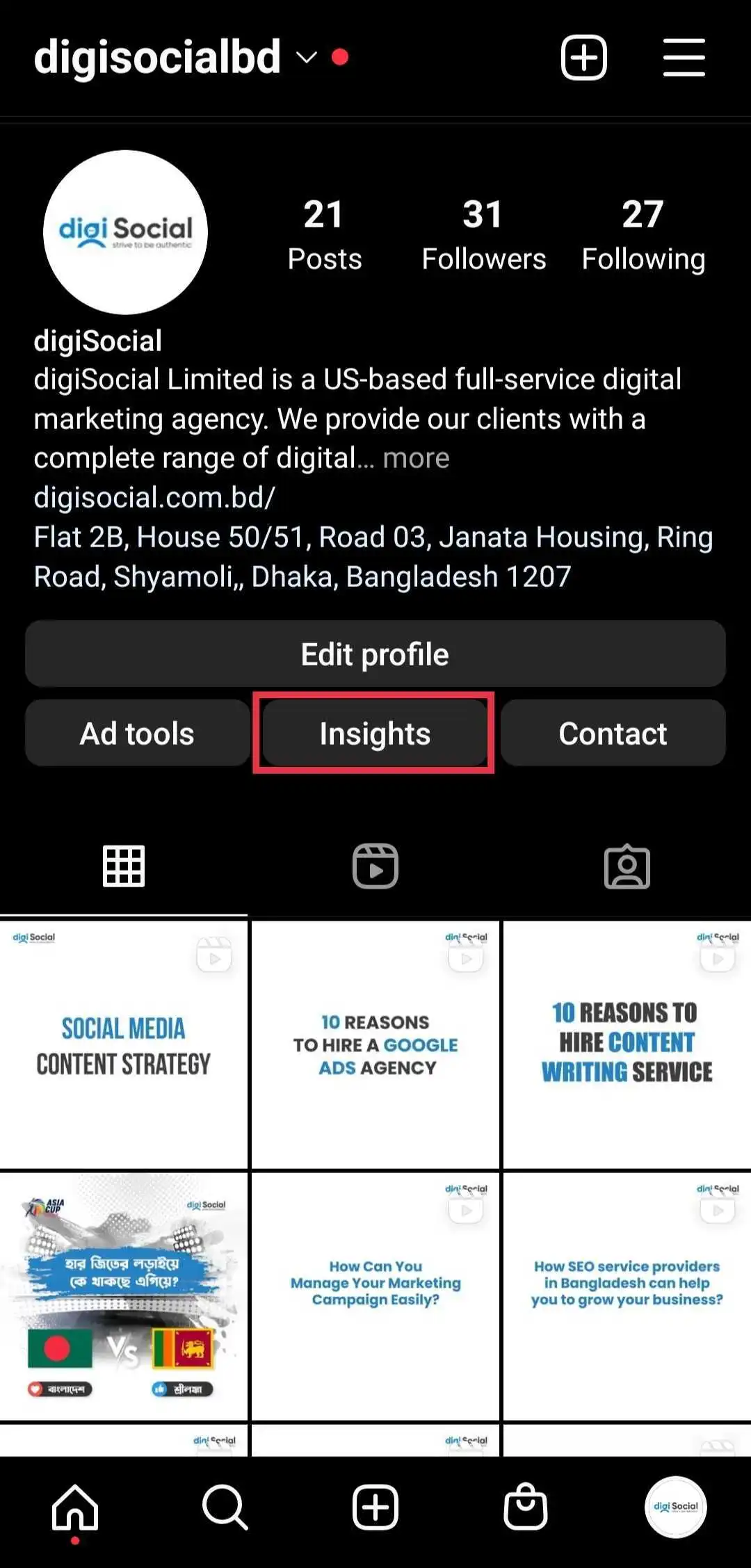
Twitter Analytics
Twitter analytics is available for all Twitter accounts, even the non-professional ones. Just tweet something and tap “View tweet insights”. You can view tweet engagements, impressions and interactions on your tweet. How does this help you? You’ll know what timings, themes and hashtags work best for your Twitter ad campaigns.

Pinterest Analytics
Pinterest analytics is a free tool that records how many people are viewing your profile, how many are following you and how many are interacting with your pins. It also provides information on the gender, age range and location of your audience.
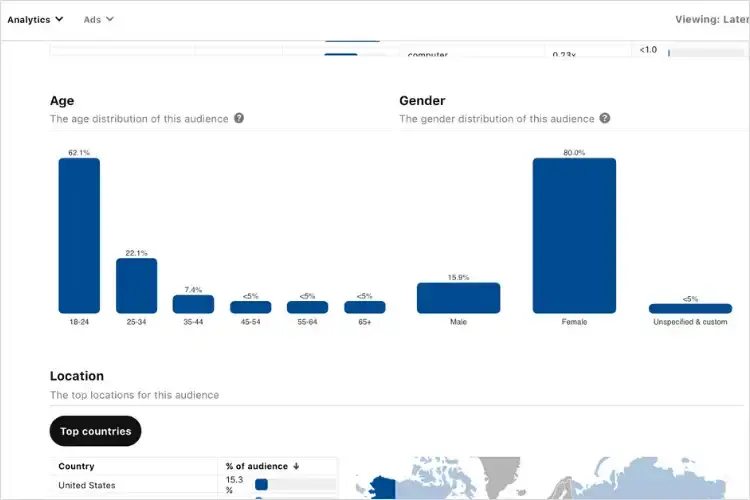
LinkedIn Analytics
Manage all your LinkedIn analytics from inlytics. Get insights on your profile views, post reach, engagement and impression. You can also check the region of your audience.
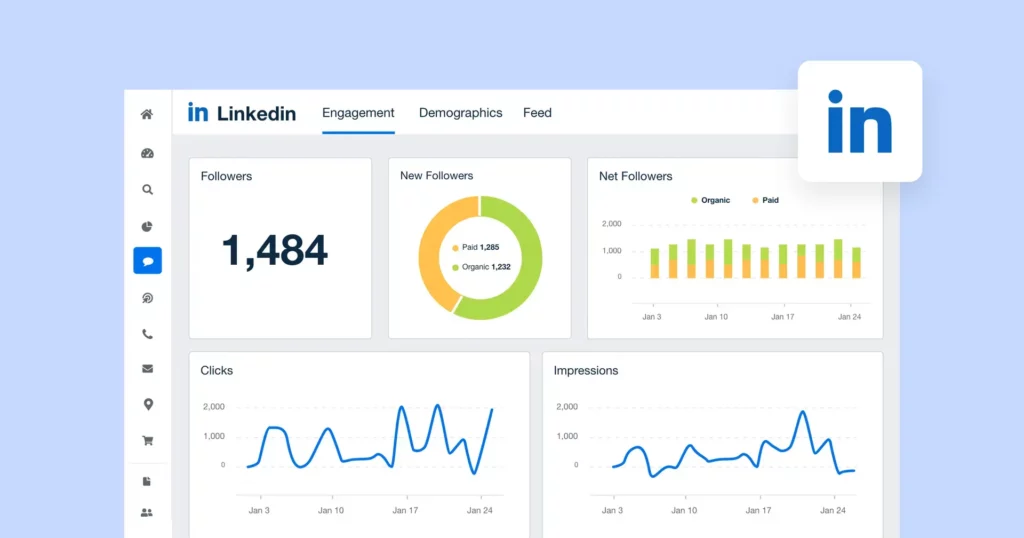
Social Blade
Social blade is a free website that shows you current, past and future statistics for YouTube, Instagram, Twitter and other social platforms. This insightful site helps you predict your social media performance and tells you which platforms you should focus on more.
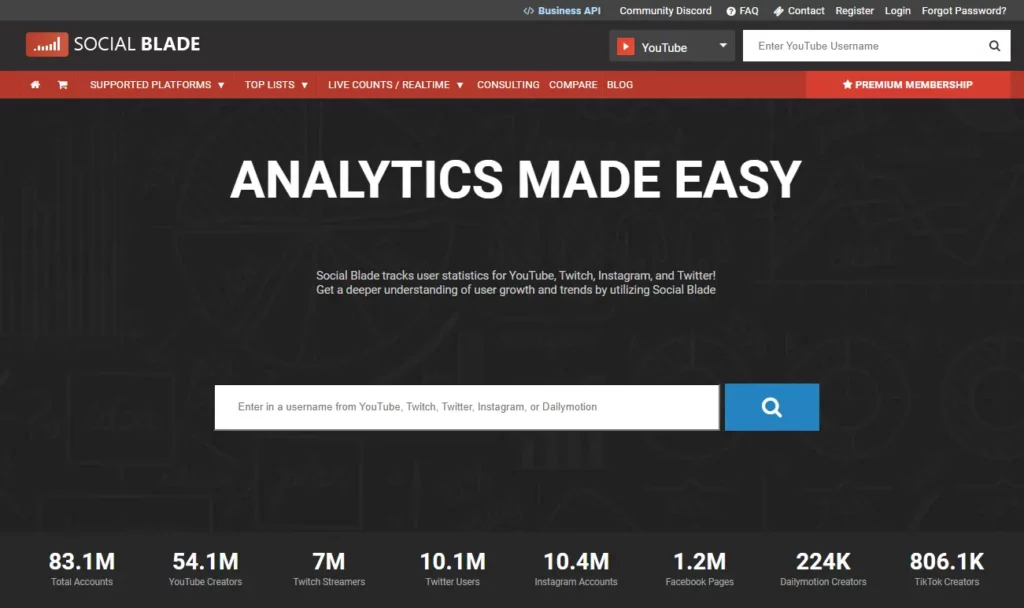
Paid Social Media Analytics Tools
Built-in and free tools are great, but they’re mostly designed for just one specific platform. With paid social media analytics tools you can get access to more statistics on different platforms – all in the same app!
Read also: Best Tools to Make Infographics
Here are some paid tools that will provide you insight into the overall state of all your social media profiles:
vi) Social Listening
What is social listening, you ask? It means keeping up with what’s being said about your brand or industry online. This is a great way to understand what your customer wants and which people need your services.
What kind of data can be monitored in social listening?
- Brand or product related hashtags.
- Mentions (@) of your social media accounts on social platforms.
- Conversations on social media platforms about your brand, services or products.
- Discussions on your brand or business in public forums or communities.
- Products or services that are creating a buzz among your customers.
The Benefits of Social Listening
After collecting data through social listening, you can analyze it to gain insight into:
- Services your customers prefer the most.
- Services your customers are not satisfied with.
- Services you don’t already provide, but should include.
- The type of targeted ads or content that your audience likes the most.
- The social media platform where your audience is most active.
Here is your social listening checklist:
Social listening strategy: Decide a fixed time for checking your interactions and for replying. Decide on the platforms you’ll be surveying, tools you’ll be using and ad campaigns you’ll focus on.
Social listening tools: Use tools that will monitor your social media mentions, replies, questions etc. Here are some social media listening tools:
Social listening data: Collect the data gained from your social listening tools and analyze them.
Social listening report: Arrange the collected social listening data into an easily readable and reflective report. You can refer to this report whenever you want to make changes to your social media analysis strategy.
vii) Create A Community
Creating a community related to your business will keep you up to date with the trending topics in your market and you’ll know what sectors you should focus on.
Social media platforms ideal for community building are:
- Facebook: Facebook groups, Facebook pages and messenger groups.
- Instagram: Instagram pages, groups and hashtags.
- Reddit: Subreddits and threads of discussion.
- Quora: Quora is a question and answer platform where people ask questions related to any topic and other users on the site try to answer them. Answer questions about your business and participate in discussions.
- Personal forums: Forums that you create related to your business or brand where people can post their inquiries and get answers from you or other members of the forum.
- Tumblr: Tumblr isn’t much popular in Bangladesh yet, but it’s a great community-building site where you can use hashtags relevant to your work to post about similar topics.
You can create a community by using the community tab on your YouTube channel as well. These communities build trust among the users and bring in more consumers who are curious about your business.
Targeting Audiences On Different Social Media Platforms
Almost everyone uses at least one social media platform. The huge number of active social media platforms are split across the different platforms. So you’ll have to go looking for your target audience across these different platforms as well.
How To Find Target Audience On Facebook
Facebook is the most used social media in the world with almost 2.9 billion monthly users. This staggering number of users makes it the perfect platform to target with your tailored ads and content. Bangladesh alone has over 44.7 million monthly Facebook users.
Let me provide some tips you should keep in mind when conducting audience research on Facebook:
Over 80% of users worldwide visit Facebook through their mobile phones. So make your ads and content mobile-friendly.
Maximum Facebook users are 13 years old and above. Keep the age of your target audience in mind when planning your social media content strategy.
Use Facebook analytics tools to narrow down which age group is visiting your Facebook profile the most, who is interacting the most, where the maximum users live and what time the users are most active.
Research Facebook pages similar to your brand and analyze their followers. These are your potential customers.
Join Facebook communities or groups related to your market. You’ll find potential customers here who might be looking for your services.
Use Facebook and Messenger ads after conducting target audience research on Facebook.
Read also: How to Create a Retargeting Ad on Facebook
How To Find Target Audience On YouTube
YouTube is one of the most used sites in Bangladesh with over 34 million monthly users. That’s over 65% of the total internet users in the country. The Google ads on YouTube reached 20.6% of the country’s population. (src: datareportal.)
The scope for establishing your target audience on this platform is huge. So don’t wait any longer. Advertise your business on YouTube!
Keep these in mind when researching audience on YouTube:
57.9% of total ad viewers on YouTube are male and 42.1% are female. Tailor your ads based on which demographic you plan to reach.
Monitor when your channel gets the highest watch time.
Note down analytics like user age, gender, location and preferred media language. Use this data to create personalized ads and content.
Keep your ads and videos short, catchy and trendy. This increases the number of shares and interactions on your channel.
Check out the comments on your channel regularly to know what your viewers like or dislike and what they want to see. These commenters can also be your potential consumers.
Link all your social media in your channel’s ‘about’ section.
Visit channels similar to yours and analyze their viewers and commenters.
How To Find Target Audience On LinkedIn
In recent years, the amount of LinkedIn users in Bangladesh has increased as people are bringing their job searches online. Over 5.3 million active users have been recorded in Bangladesh as of July 2022. These users regularly look for job opportunities and services that may just be related to your company.
LinkedIn Marketing is now one of the most fruitful marketing strategies.
Where do you look for your target audience on LinkedIn?
Start out with an audience template. This audience template will include audiences based on their profession, work experiences or other demographics. Using the template you can identify the needs and demands of your target audience.
Analyze your followers’ demographics like age, location, job experience, skills, etc. research other pages or LinkedIn profiles that your audience follows or interacts with to find people with similar needs.
A/B test your audience when launching a LinkedIn Marketing campaign and adjust your strategies accordingly.
54.4% of LinkedIn users in Bangladesh are aged between 25-34 years and the second highest number of users are aged between 18-24 years. (src: napoleancat) So post content on LinkedIn that appeals to these demographics.
How To Find Target Audience On Instagram
Instagram has over 1.3 billion active users worldwide and 5.4 million of these users are in Bangladesh. Bangladeshi people spend a long time on their phones, sharing pictures and posts on Instagram. This platform is crowded with people who can be your target audience.
Here are steps you can take to identify your target audience on Instagram:
Follow hashtags related to your market and industry. Find the posts that may be similar to your business and check the comments for potential customers. Your Instagram posts should be made similar to the popular posts under these hashtags.
In Bangladesh, 68.4% of total Instagram users are male and 31.6% are female. Consider this fact when making content and marketing strategy for Instagram.
The highest number of users are aged between 18-24 years and the second highest age group is 25-34 years. Knowing the dominant age group and gender on Instagram helps narrow down which group you should be focusing on.
Analyze who your audience is following. Knowing about the brands, services or celebrities that your audience follows makes it easier to specify who your future customers may be.
Research accounts similar to yours in the same market and their followers. Their followers are also part of your target audience.
How To Find Target Audience On Twitter
Twitter still isn’t widely used in Bangladesh. But you can use this platform to expand your business reach.
Here are some tips on how to find your target audience on Twitter:
Follow industry-related hashtags and note down accounts who interact with these tags.
Analyze the accounts of your competitors and their followers. Also, research the accounts your audience follows and interacts with.
Join Twitter group chats and communities related to your brand to gain information on the consumers.
Note down the behaviors of accounts that interact with promoted or paid content.
Most Twitter users are aged 13 and above so your content needs to be tailored to certain age groups.
Keep your tweets short and catchy. Adding images, gifs or similar media helps boost your tweets.
Now that you’re done collecting, what will you do with all this data on your target audience?
You use it for audience segmentation.
What Is Audience Segmentation?
Audience segmentation is the process of grouping or categorizing your audience using unique characteristics like their age, gender, occupation, salary range etc.
From this definition of audience segmentation, maybe you’ve already understood the basic concept. So let’s dive further into it.
What are the benefits of audience segmentation? Is it worth your time?
Let me list some ways this process helps you:
- You can improve your ROAS (Return on Ad Spend) by making more precise and tailored ads
- You can be aware of your audience’s wants and needs.
- You can supply specific products or services depending on what your focused audience demands.
- Focusing on specific target classes improves ROI (Return on Investment) as it cuts down your marketing and production costs.
- You can set goals, KPIs and budgets focusing on each audience segment and monitor them separately.
Segmenting your audience into different groups makes your life so much easier! Instead of swallowing a whole pie, you can savor it slice by slice. Okay maybe that’s not the best way to describe your audience, but you get the idea!
Learn more: Audience Segmentation in Digital Marketing
Different Types Of Audience Segmentation
There are 4 main kinds of social media target audience segmentation:
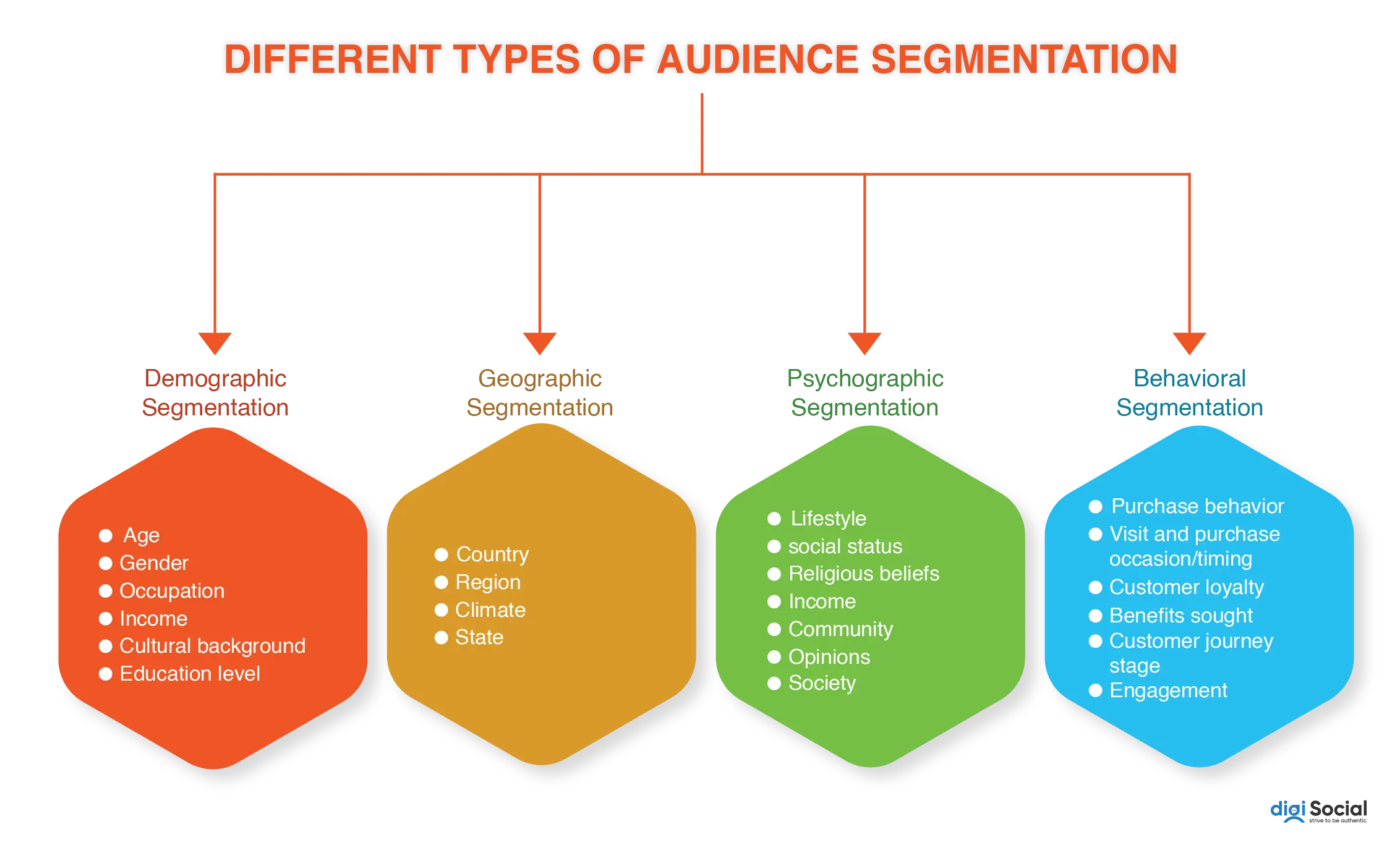
From the above, you can guess that one person may belong to more than one audience segment.
Suppose, Habib is a university student who buys a new shirt around Eid each year. From just this sentence you can classify this customer into 4 categories: gender(male), age range (20-25 years), purchase behavior (twice a year around Eid) and religious beliefs(Islam). He belongs to more than one group simultaneously(at the same time). So you can market your shirts to Habib by offering sales, offers or making Eid-themed ads.
Segmenting your target audience on social media prevents any audience leakage in your marketing funnel. How? Because you don’t overlook or ignore any potential customers with specific needs!
Audience Identification Tools
So far we’ve covered where to look for your target audience, how to collect data on them and how to use it to segment your audience.
Now let me list some target audience identification tools to make your life even easier:
- Google Trends
- Google Analytics
- SEMrush
- Audiense
- Cloohawk
- AgoraPulse
- Google Keyword Tool
- Statista
- Tableau
- Think With Google
